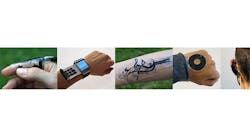Touch-sensitive, mobile-device controls that lie outside the confines of a screen—dubbed “iSkin”—are currently under development via a joint effort between Saarland University and Carnegie Mellon University.
Thin, flexible, and biocompatible with human skin, the new sensor pads provide convenient controls on fingers, forearms, ears, and hands. They can be wrapped around body parts and secured with Velcro, attached to other devices such as the Apple Watch, or stuck to the body using medical-grade adhesives. The iSkin stickers can be easily applied and removed without pulling out body hair.
The research team attributes the concept of i-Skin to other human-computer interaction (HCI) technologies, such as UC Berkeley’s electronic Skin (e-Skin). Resistive and capacitive sensors incorporated into iSkin enable two levels of pressure sensing: hard press and light touch.
Early-stage prototypes include volume sliders, incoming-call controls, and music controllers. They use cables for transmitting signals and receiving power, but a wireless design is on the research roadmap.
The sensor pads are made of polydimethylsiloxane (PDMS), a sheer organic polymer that can be stretched by 30% and bent at a radius of 0.5 in., making the controls functional at joints and compliant with natural stretching of the skin. Carbon-treating the PDMS makes conductive cPDMS, which forms the electrodes and conductive lines. Perforated PDMS is used between transmitting and receiving electrodes for effective capacitive and resistive sensing. Its hexagonal pore design minimizes the effect of stretching on sensor capabilities.
The top and bottom sealing layers of the stickers are made out of non-conductive PDMS to protect the internal electronics and protect the skin from shock. Receiving and transmitting electrodes are etched on separate layers of cPDMS, separated by a layer of PDMS that is perforated where electrodes are located. The layers are glued together with uncured PDMS. The stickers measure a mere 190 µm without electrodes, and 700 µm with electrodes and wiring.
In testing, a 5-V square-wave signal is supplied to the transmitting electrodes. As the user presses hard on the iSkin, the receiving electrode makes contact with the transmitting electrode through the holes in the perforated PDMS layer. This causes the charge on the receiving electrode to change, and it sends this signal to the microprocessor.
With capacitive sensing, a small touch from the user brings the electrodes closer together, increasing the mutual capacitance and decreasing the input signal. This information is then relayed to the microprocessor. Due to the capacitance’s high sensitivity, the iSkin is calibrated after application to the skin to determine a threshold pressure. Capacitive sensors are time-division multiplexed for serial activation in volume slides and other light-touch devices.
The two levels of pressure sensing allow for controls such as click wheels and sliding gauges.
Watch a video on iSkin, courtesy of Engineering TV, below:
To learn more about the benefits, limits, and future plans of this project, read the report, iSkin: Flexible, Stretchable and Visually Customizable On-Body Touch Sensors for Mobile Computing, winner of the ‘Best Paper’ Award at the SIGCHI conference for its developments in HCI research.
